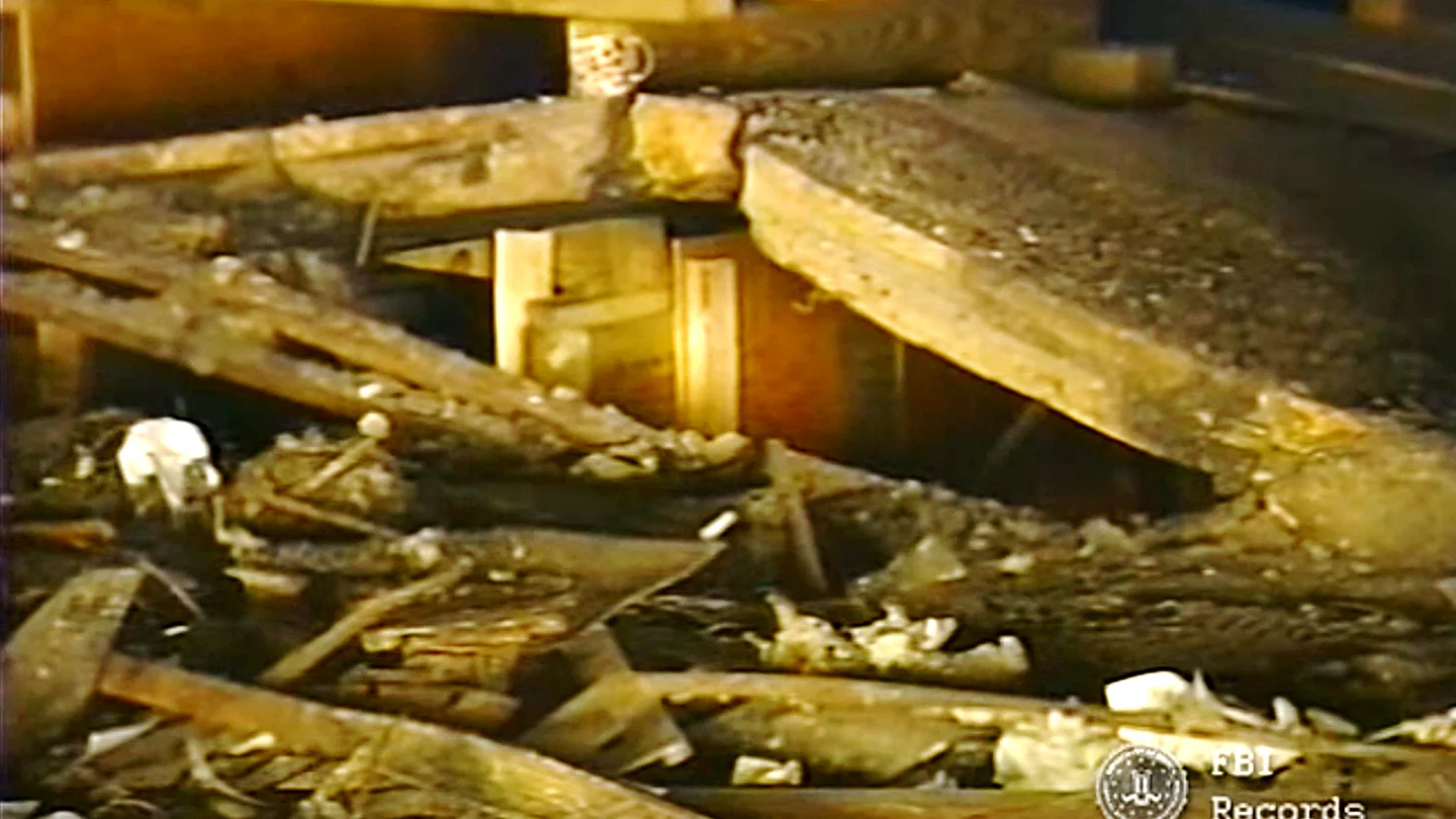Editor’s Note: Response papers are welcome through June 22, 2024.
As part of the long running controversy about what happened at the Pentagon on 9/11, the curious damage to a portion of the second-floor slab has sustained many wide-ranging speculations. The reason for these speculations is that the mechanical damage from the impacting aircraft largely was contained between the first and second-floor slabs and the destructive momentum was, effectively, only horizontal. The source of a significant vertical mechanical force powerful enough to snap and uplift a portion of the second-floor slab has not been previously identified. An exhibit about the Pentagon at the 9/11 Memorial Museum in New York City provides one explanation—that of an exploding fuel tank beneath it. However, a survivor from the immediate vicinity of the alleged explosion does not recount any such explosion, let alone one powerful enough to snap that slab into two pieces. In this paper, an explanation for the vertical mechanical force will be presented that is based on the gyroscopic properties of the rotating engines.
The Uplifted Slab
The uplifted second-floor slab is the most prominent evidence for a powerful vertical force originating from within the first floor. The sharpness of the break and “tenting” shown in Figure 1 clearly suggests a mechanical origin rather than the fracturing and crumbling of concrete that a pressure-wave blast from below would have created.
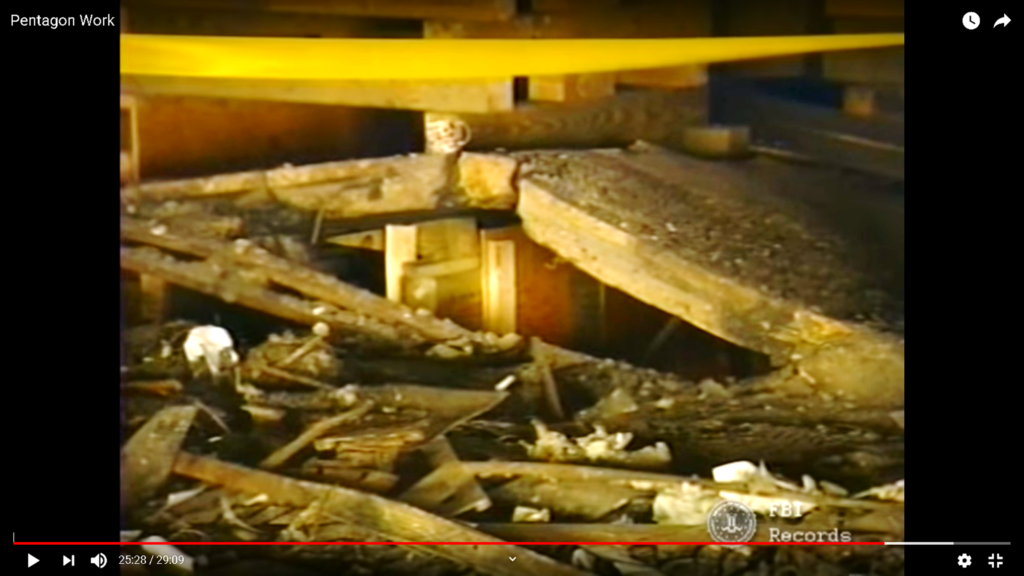
Precession: The Vertical Redirection of Horizontal Mechanical Forces
The source of the vertical mechanical force has eluded analysts investigating the Pentagon for over two decades. Additionally, a related question that has been asked frequently is “what happened to the engines, they should have continued through the Pentagon like a multi-ton battering ram.” The answer to these questions requires an understanding of the dynamics of rotating engines.
The engines were rotating at up to 40,000 revolutions per minute at time of impact and therefore had significant rotational inertia. Due to gyroscopic effects, this rotation would change a “multi-ton battering ram” with horizontal linear momentum into a tumbling and bouncing mass wreaking pandemonium. This mass would be capable of exerting large vertical forces capable of snapping the second-floor slab in two. Additionally, this violent, chaotic motion would have most likely fractured and dissembled the engines into smaller component pieces rather than leaving the engines intact to continue through the first-floor space like a battering ram. Figure 2 shows the gyroscopic concept of precession2 where a horizontal torque applied from the right will not create a horizontal acceleration to the left, but rather it would tend to reorient the engine in a vertical direction.

In the case of the impacting 757’s rotating left engine, the engine would have initially been bolted to the left wing and would have experienced significant horizontal forces that would have created vertical forces. A multi-ton engine spinning with a high-speed rotation would have created powerful vertical forces.
Location of the Uplifted Slab
The uplifted slab is located inside the D-Ring of the Pentagon, approximately 100 feet from the exterior façade where the damage trail from the impacting aircraft begins. Figure 3 shows the location of the uplifted slab as a tan rectangle. In terms of column-based coordinates, the location is bounded by columns E5, E7, G7 and G5.
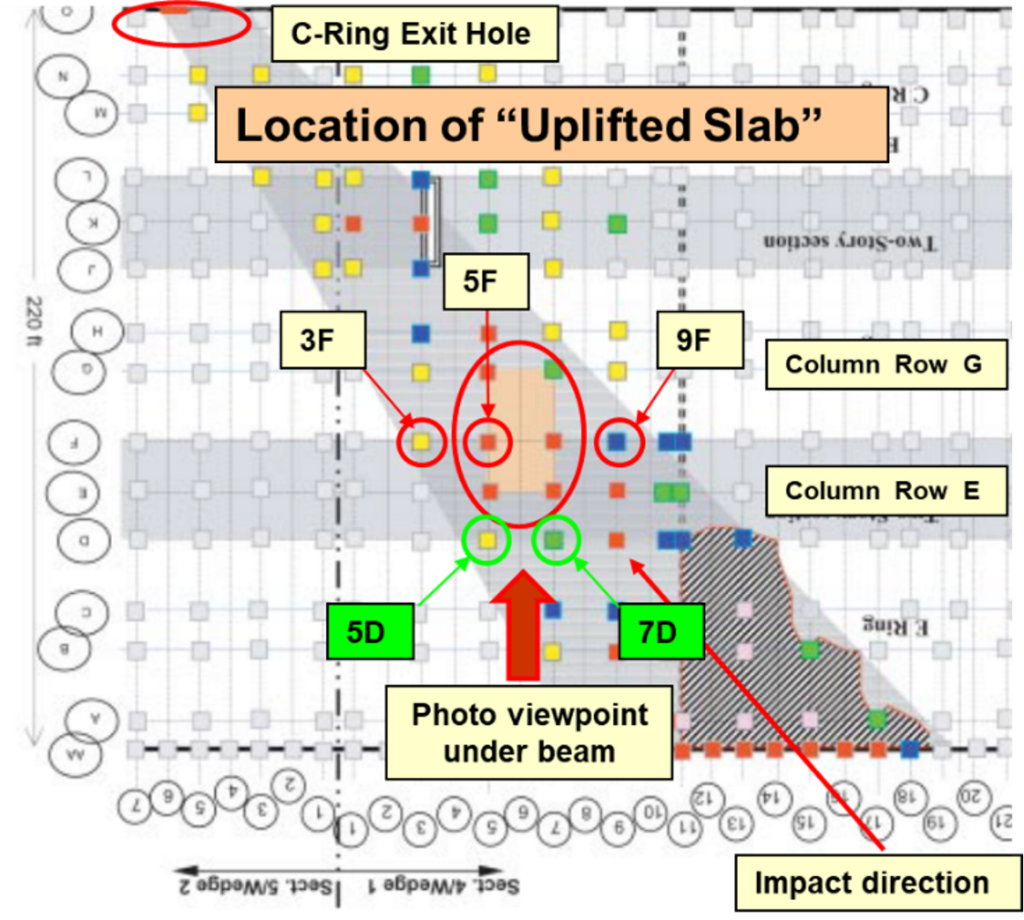
A photographic record of the area underneath the uplifted slab is shown in Figure 4. Several columns are identified to clarify their locations to facilitate comparisons in Figure 3. While this photo was taken during the clean-up, there are no signs of a significant detonation capable of snapping and uplifting a small, localized area of the second-floor concrete slab.

Survivor In the Vicinity of the Uplifted Slab
Major David King was in room 1D518 which is believed to be nearly adjacent to 1E517 where April Gallop was stationed at the time of impact. The location of King’s office is shown as a red square in both Figure 5 and Figure 6
and was near the area under the uplifted slab. A blast with enough force to snap and uplift a concrete slab would have been a very noticeable event to anyone in the vicinity. King did not recount an explosion4.
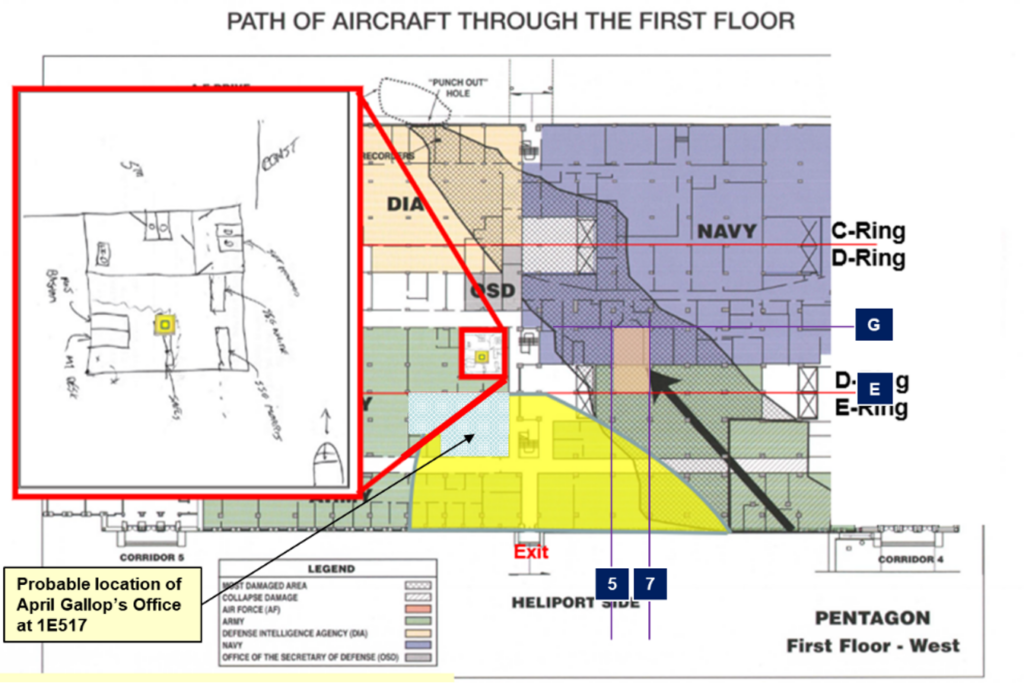
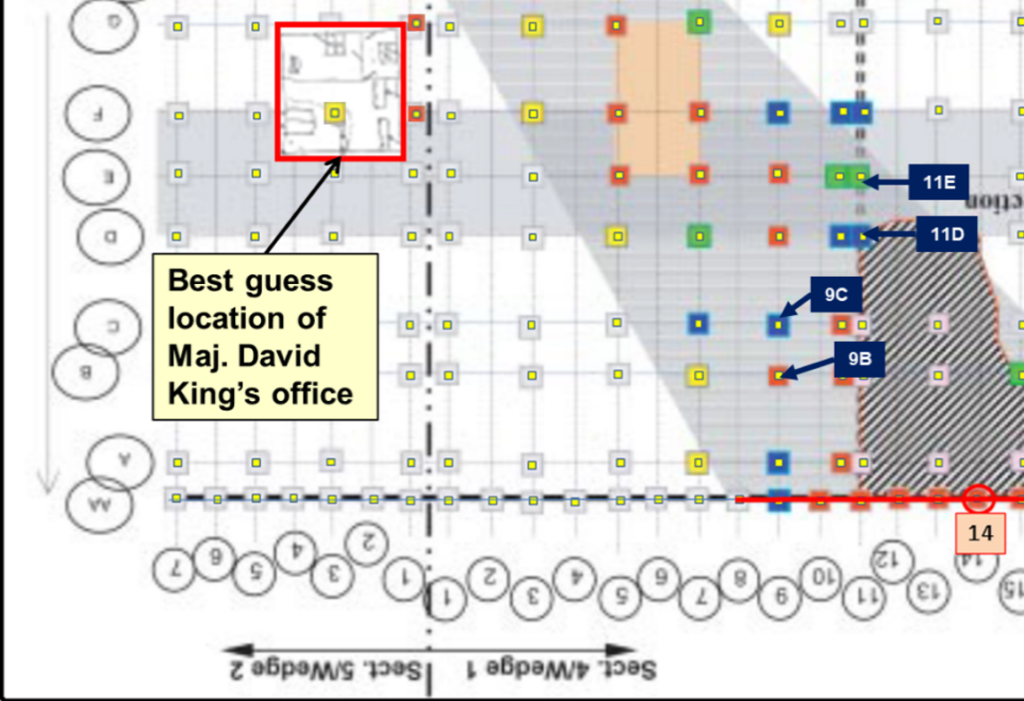
The following is a portion of an interview given by Maj. David J. King Jr. to the Center for Military History:
MAJ. KING: … I was in 1 Delta 518 … When the plane struck, the entire wall behind me that goes into the E-Ring was knocked askew… What I did notice, the whole office erupting in flame … I don’t remember a large noise. I do remember thinking, “Why is my head not ringing and why is all this—why is this place in rubble?” You know, I was thinking of a truck bomb.
CAPT. DOVER: Describe what you heard. What did you hear?
MAJ. KING: I don’t remember hearing a crash. All I just remember is the whole place erupting in flames. I don’t remember a large crash or anything. And that was—I remember standing there: “Why isn’t my head ringing?” Because an explosion would definitely ring my bell [e.g., a ringing in the head is a frequent phenomenon for those in the vicinity of an explosive detonation] …
Explanation from a Display at the 9/11 Memorial Museum
Figure 7 shows a floor plan for the second-floor of the Pentagon that was on display at the 9/11 Memorial Museum. The vicinity of the uplifted slab is shown by a blue/white hash-marked area and the legend for this region says “Fuel Tank Explosion.” Given the lack of any other explanation, this seems to be a best-guess explanation even though there are contraindications; the impossibility of an explosive mixture of jet fuel 100 feet into the building (jet fuel is formulated to be flammable, but non-explosive) and David King’s survivor’s story.

Trajectory of the Left Engine
The physics of the impacting aircraft and evaluation of the damage has been discussed in various papers and videos8. As shown in Figure 8, the damage to the diesel generator trailer establishes the height and path of the right engine. Additionally, a notch that was gouged into a concrete retaining wall establishes the location and height of the left engine. This paper will focus on the trajectory of the left engine.

Figure 9 shows an approaching plane with the dimension of a Boeing 757 as well as the diesel generator trailer and the gouged retaining wall.

Once the right engine impacts the diesel generator trailer, the plane began a yaw rotation (around its z-axis). The sequential forward motion of the left engine is shown as a series of discrete steps in Figure 10. A red line traces the location of the left engine through the retaining wall and into the building at an angle of about 56 degrees instead of 52 degrees for the plane’s center of mass.


Figure 12 and Figure 13 show the gouged retaining wall from different perspectives. Figure 14 shows three images and dotted lines showing the approximate path of the left engine into the Pentagon façade.



Once the engine impacts and gouges the retaining wall, there is no other evidence for the path of the engine until its apparent impact with columns 9B and 9C.
With the implied height at the left engine roughly established by the gouge, Figure 15 illustrates the height of the left engine inside the Pentagon by aligning the left wing with the maximum indent in the bent-and-bowed column 9AA as well as the fuselage impacting the lower three feet of column 14AA on the second-floor. At this height, the left engine will be inches above the floor and will impact column 9B – leaving its unmistakable impression in the form of an arc that was bashed into the column’s steel-reinforced concrete.
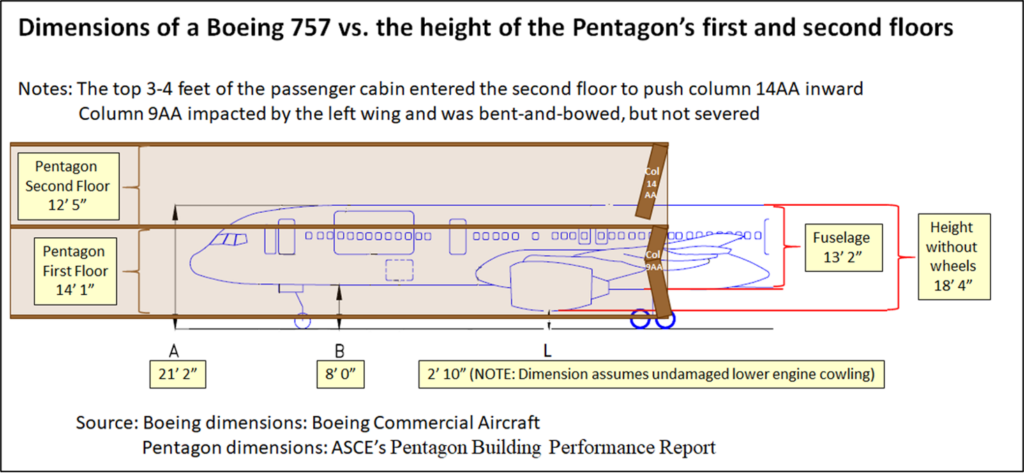
Figure 16 traces the trajectory of the left engine inside of the first floor as it impacts column 9B, 9C and potentially other columns. From the damage to the right side of column 9B in association with damage to other columns, it is assumed that the engine was deflected to an angle of about 62 degrees and this horizontal force imparted the gyroscopic vertical rotation. With this change in direction, the engine would miss column7D. This would place the engine directly under the uplifted slab with a tumble and bounce motion that would create the upward force to snap and uplift the slab.
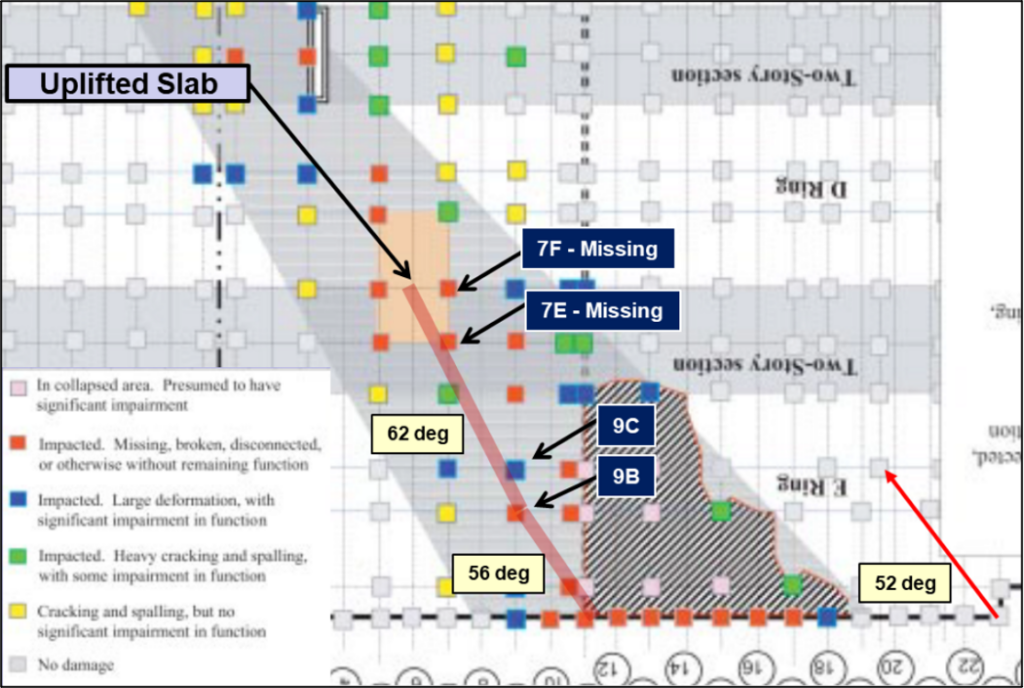
Column 9B and 9C are shown in Figure 17. They are both impacted and bent in the direction of the impacting aircraft.

Figure 18 shows damage consistent with a large roundish object approximately 6 feet in diameter passing by and impacting. This circular impact damage is highlighted by a red arc.
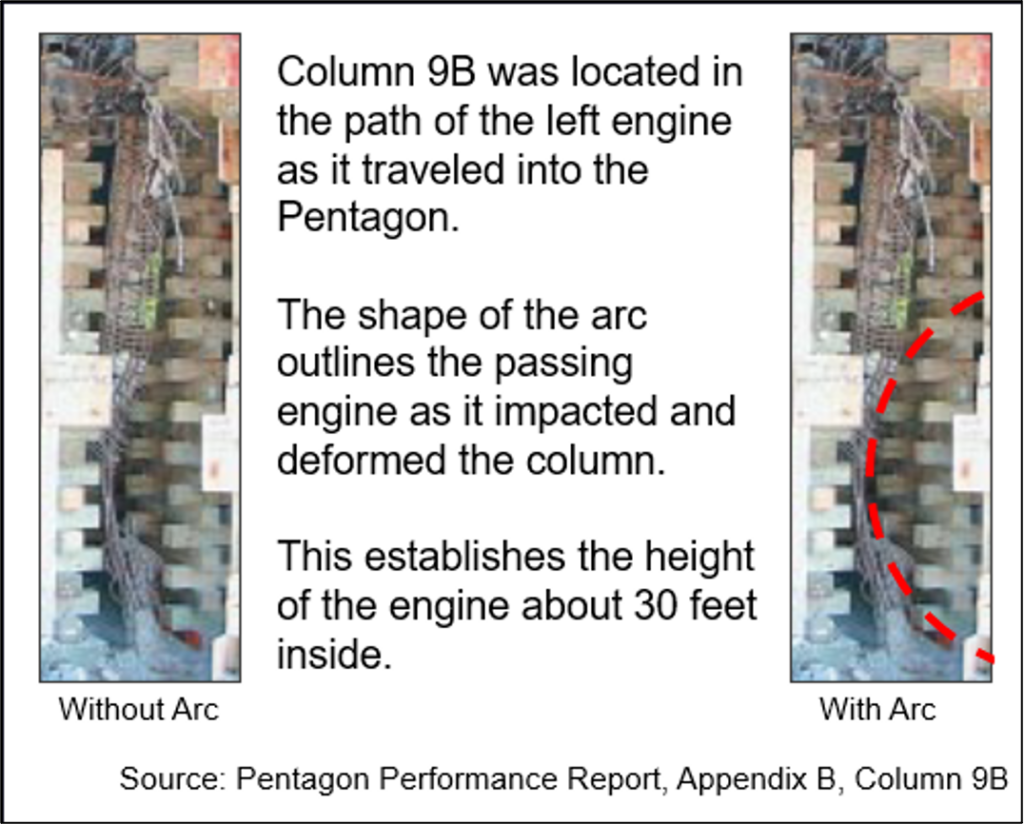
Figure 19 and Figure 20 show the damage to column 9C in the context of the overall damage where the columns are bent and bowed.
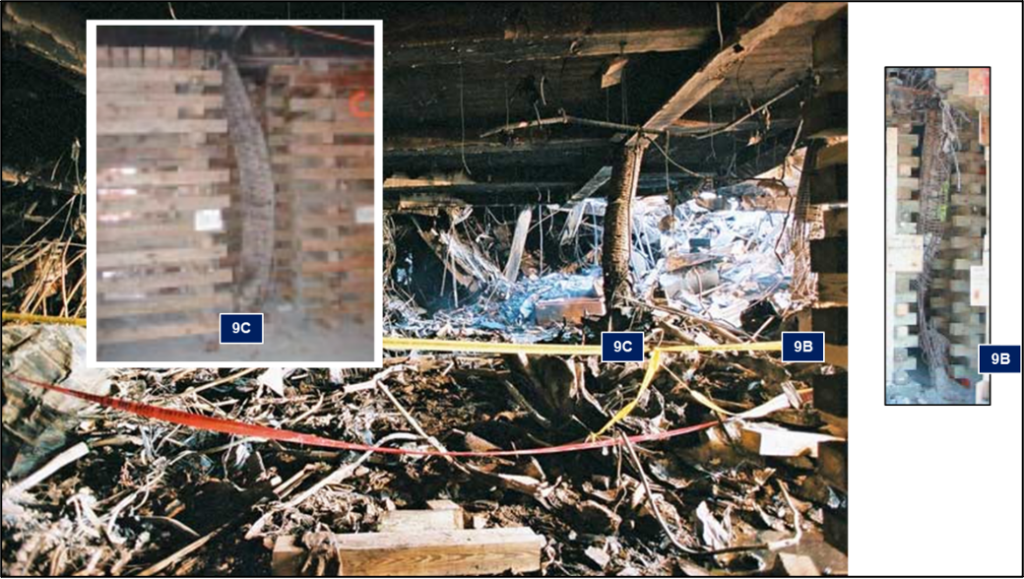
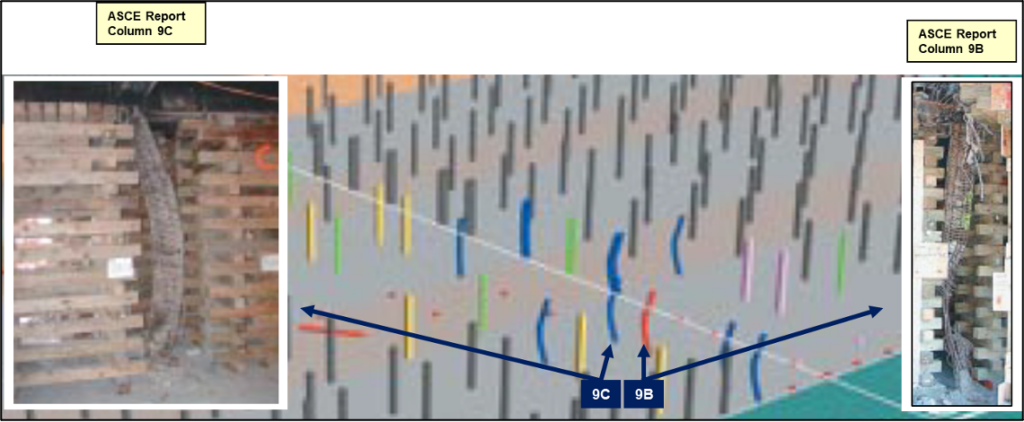
Conclusion
The controversy over the uplifted second floor slab has led many to jump to the conclusion that explosive detonations were present. However, an explanation that is consistent with the physics of simple mechanical motions has herein been developed to explain the peculiar snapping and “tenting” of this slab.
References
- Pentagon Work, FBI – Federal Bureau of Investigation, https://youtu.be/pyBMUSPpIP8?si=3XB07AgKk5opnRjn&t=1500
- Gyroscopic Theory | Gyroscope and Gyroscopic Working Principles | Lecture 25, https://youtu.be/JtniROSrovs?si=BBHJYB1NEv9gOuxJ and/or Gyroscopic Precession — An Intuitive Explanation, TheHue’s SciTech, https://www.youtube.com/watch?v=n5bKzBZ7XuM
- https://commons.wikimedia.org/wiki/File:FEMA_-_4934_-_Photograph_by_Jocelyn_Augustino_taken_on_09-21-2001_in_Virginia.jpg
- Coste, Wayne, Peer Review of Barbara Honegger’s Parallels Between the WTC and Pentagon Evidence and Why It Matters, https://youtu.be/7nxdThV4egA?si=lsGY-FisNJ8C4ibB&t=1914
- Stephen J. Lofgren . Then Came the Fire, https://history.army.mil/html/books/070/70-119-1/CMH_Pub_70-119-1.pdf
- Arlington County After-Action Report on the Response to the September 11 Terrorist Attack on the Pentagon, https://permanent.fdlp.gov/lps21127/after_report.pdf
- Mlakar, Paul E., et al. “The Pentagon building performance report.” American Society of Civil Engineers, 2003, https://web.archive.org/web/20171116010616/https://attivissimo.net/9-11/PentagonBuildingPerformanceReport.pdf
- https://911speakout.org/wayne-coste/
- https://commons.wikimedia.org/wiki/Category:The_Pentagon_on_13_September,_2001#/media/File:FEMA_-_4436_-_Photograph_by_Jocelyn_Augustino_taken_on_09-13-2001_in_Virginia.jpg

